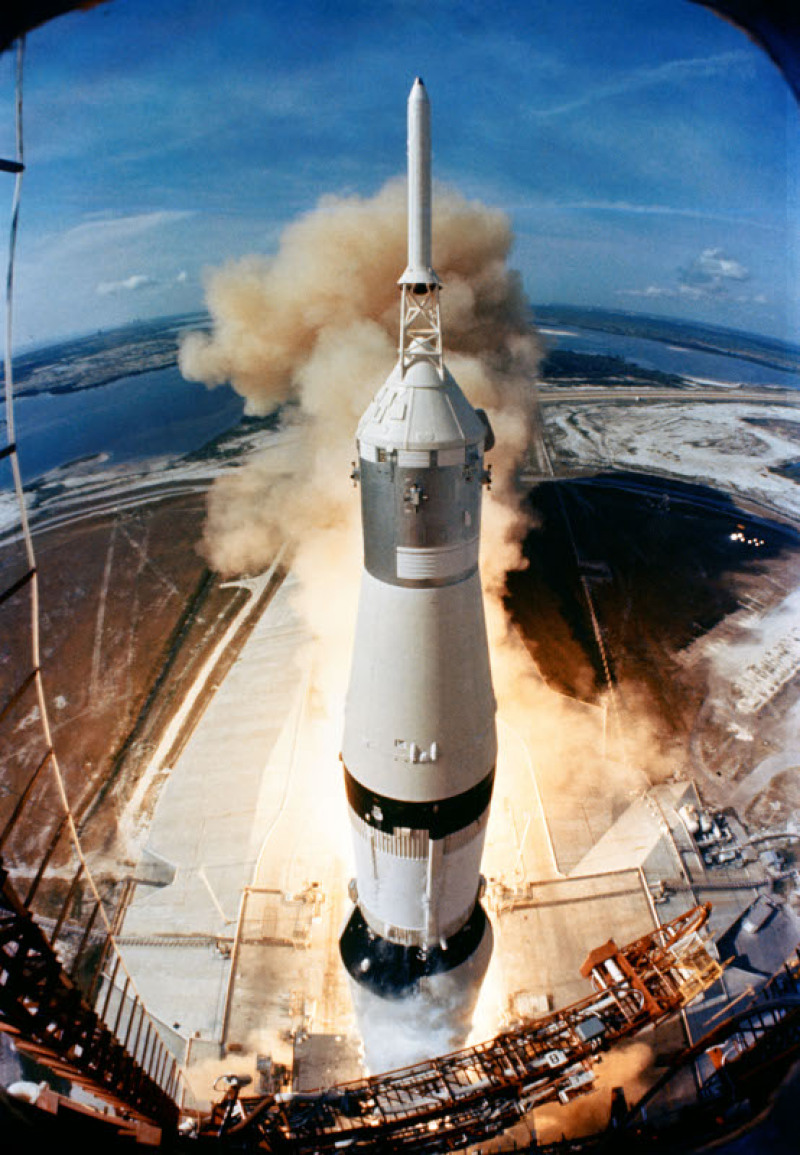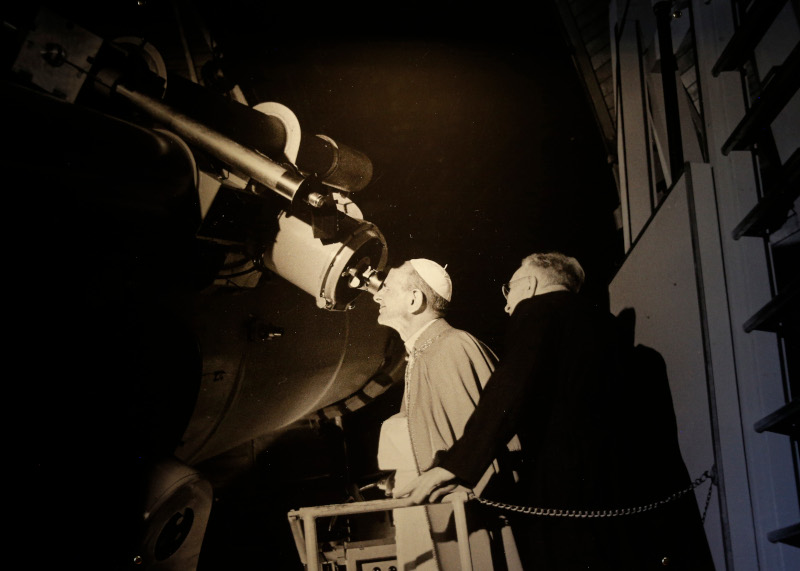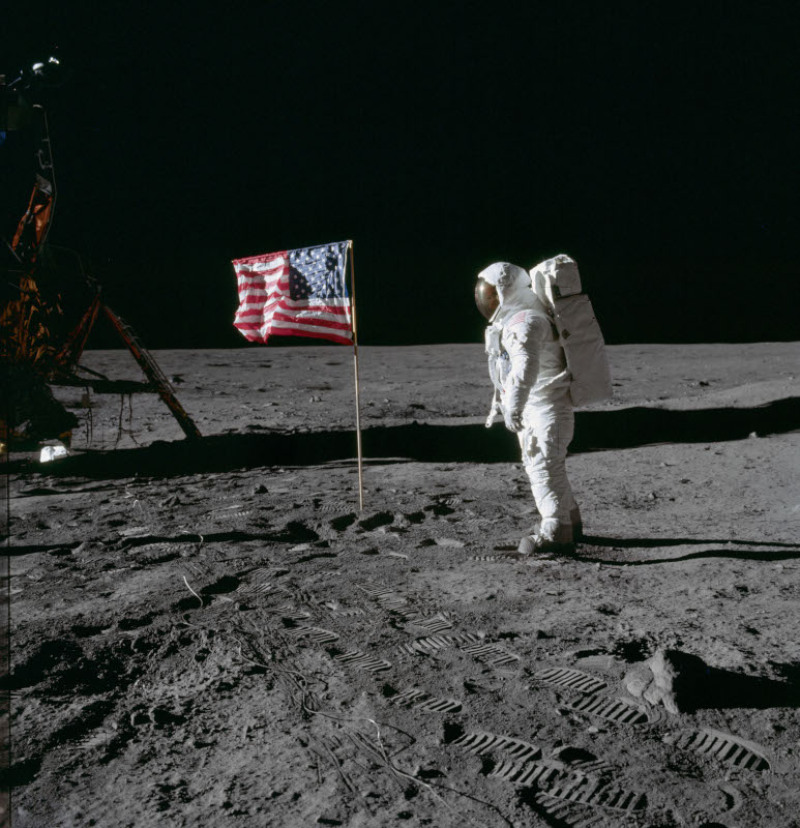
50 YEARS ON, MOON LANDING STILL GENERATES A WISTFUL SENSE OF WONDERMENT
Dennis Sadowski, Catholic News Service
07/08/2019
The Apollo 11 space vehicle is launched July 16, 1969.

Aboard the spacecraft were astronauts Neil Armstrong,
commander; Michael Collins, command module pilot; and
Edwin "Buzz" Aldrin Jr., lunar module pilot. It has been 50
years since the moon landing.
CNS photo/courtesy NASA
WASHINGTON (CNS) — When Apollo 11 astronaut Neil Armstrong gingerly stepped onto the surface of the moon July 20, 1969, Jesuit Brother Guy Consolmagno had no idea that someday, he would become the director of the Vatican Observatory.
Sixteen at the time, he had followed the space program since Alan Shepard's 15-minute suborbital flight eight years earlier. But becoming a scientist was not foremost in the mind of the teenage Consolmagno as he watched the grainy black-and-white televised images of Armstrong and Edwin "Buzz" Aldrin going about their tasks on the surface of another world.
Still, the events unfolding that Sunday evening 50 years ago left an impact on Brother Consolmagno, an avid reader of science fiction who especially enjoyed stories about what it might be like to travel into space.
That put the connection in my mind that the things we fantasize about can actually happen. So dreams carry with them an important sort of reality,” he told Catholic News Service as the golden anniversary of the first moon landing approached.
"In the long run, it made me recognize the importance of our aspirations, the importance of our dreams, but also, it ties into the Jesuit idea that I really hadn't understood yet of looking for God in your deepest desires."
Years later, Brother Consolmagno would pursue studies in astronomy and then enter religious life. Today he heads one of the most prestigious astronomical institutions in the world while living his vocation and continues to marvel at the possibility of traveling to other planets. He sees God's handiwork in it all.
"I can feel God in any of that work," he said. "To me, you feel God in the joy of the moment. That the universe is logical and the fact that there is also beauty and understanding, it is a source of joy."
The accomplishments achieved through scientific endeavors such as the moon landings can provide a glimpse into the way things work and what it means to be human, both key components of God's creation, said Franciscan Sister Ilia Delio, professor of theology at Villanova University.
"It tells us about us and our capacity to invent, to discover that which has never been seen, that which has never been walked upon," she said. "It tells us about the human person and the openness to this creation that God has given us the freedom to explore."
Discovery also can serve — if humanity allows — to help people realize the universe is so much larger than the planet human beings currently inhabit, Sister Delio explained.
"It's obviously very, very hard for us to get our heads around the fact that we are on a planet that's moving through space, that space is filled with all sort of material life and perhaps intelligent life that we have yet to discover. But the landing on the moon shows we can discover new things when we thought never before this could be done," she told CNS.
"That's what these discoveries are pointing to: a humble stance in this incredibly vast cosmos."
The first moon landing itself was not without its religious connections. In preparation for the historic Apollo 11 flight, messages from religious leaders were among the artifacts collected to be flown on the lunar lander, reported National Catholic News Service, the predecessor of CNS. They remain there to this day for posterity.

Pope Paul VI views the moon through the
viewfinder of the Schmidt telescope at the
time of the first landing on the moon,
July 20, 1969. This print was photographed
on display at theVatican observatory in
Castel Gandolfo, Italy, Sept. 28, 2018.
CNS photo/Paul Haring
The messages include one personally penned by St. Paul VI alongside the printed text of Psalm 8: "For the glory of the name of God, who gives men such power, we pray and wish well for this wondrous endeavor."
The pope was particularly enamored with the flight. As Aldrin and Armstrong collected rocks and set up experiments while the third member of the crew, Michael Collins, orbited overhead, St. Paul went to the observatory at the papal summer home at Castel Gandolfo outside of Rome. He looked through a telescope at the moon, eyeing the Sea of Tranquility where the first landing occurred.
Three months later, St. Paul welcomed the astronauts to the Vatican during a private 20-minute meeting.
Such wonder about what it's like on other worlds and the many natural mysteries God has planted for humans to encounter also tugs at Father James Kurzynski, an amateur astronomer who is pastor of St. Olaf Parish in Eau Claire, Wisconsin.
"Part of the human heart is to explore and discover," he said, "so why wouldn't we want to explore?"
Father Kurzynski, 45, is too young to remember the Apollo missions. "My connection was more as a Space Shuttle kid," he said. But he held a deep fascination with the heavens and over the years he has read about the history of spaceflight. That's how he encountered Aldrin's description of the stark lunar landscape as a scene of "magnificent desolation."
"There's something to that that really spoke to me spiritually. In our spiritual life, especially in Ignatian spirituality, we talk about desolation," Father Kurzynski said. "How can we see beauty amid desolation?
"Even though at one level one can see walking on the moon as (asking), 'Why go there? There's no trees, there's no atmosphere. It's just desolate.' I would love to see an earthrise. There's something amid that desolation that can heighten that beauty," he said.
"Finding this odd sense of beauty that seems to contradict the desolation is true in the spiritual life, that there are some very desolate moments in our life," he continued. "Then there's an earthrise, something that changes our disposition of heart and allows us to view this desolation differently from the standpoint of profound beauty as opposed to lifelessness."

Astronaut Edwin "Buzz" Aldrin, lunar
module pilot of the first lunar landing
mission, poses for a photograph beside
the deployed U.S. flag during an Apollo 11
extra-vehicular activity on the lunar surface
July 20, 1969.
CNS photo/courtesy NASA
So when Father Kurzynski shares with friends or parishioners a telescopic view of the moon, the planets or a deep sky object, he feels he is sharing insight into the beauty God has spread across the universe.
That leads Father Kurzynski to the question why humanity has not been to the moon in nearly 50 years.
"When we go back, how will it be received and what kind of missions will go forth in light of the technical changes we've had?" he wondered. "My hope is when we go back to the moon, I'm hoping that citizen science programs will not only increase the interest in the moon landing, but also increase future citizen contribution to the moon landing."
Such involvement might yet again get people excited about space exploration and, by extension, think about the place of humanity in God's creation, said Duilia de Mello, vice provost and professor of physics at The Catholic University of America.
"We today are losing a little bit of touch. We need that kind of experience (of the celebration of discovery) to get perspective and see the planet from above and see how small we are in the universe, and at the same time see how special we are," de Mello told CNS.
While de Mello was just 5 during the first moon landing and has no memories of the event, as a young teenager she started reading about interplanetary space probes that the popular media widely covered in the 1970s. That exposure moved her to become an astronomer and she now studies the structure of galaxies and works with the Space Telescope Science Institute.
She urged scientists, educators and even the Catholic Church to renew a sense of curiosity in students -- as she experienced -- so they can better connect science in daily life.
It just may be inspire some of those students to help achieve humanity's first landing someplace other than the moon.
- - -
Follow Sadowski on Twitter: @DennisSadowski
-
